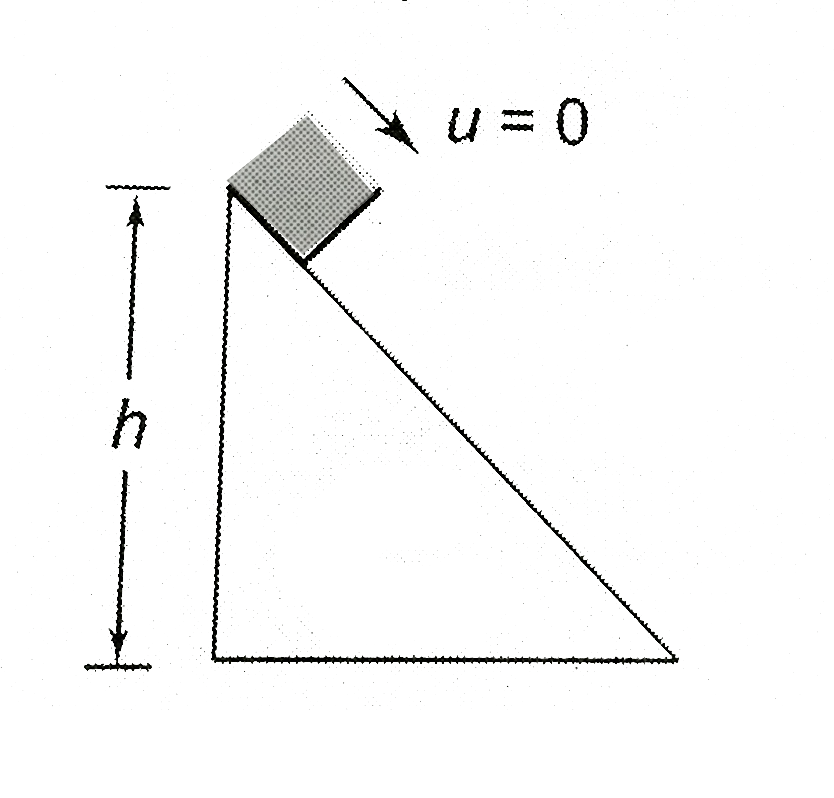A block is released from the top of an inclined plane of inclination θ. Its velocity at the bottom of plane is v. If it slides down a rough inclined plane of the same inclination , its velocity at bottom is v/2. The coefficient of friction is
34cosθ
14cosθ
14tanθ
34tanθ
The correct Answer is:D
To solve the problem, we need to analyze the motion of a block sliding down two inclined planes: one smooth and one rough. We will derive the coefficient of friction based on the given conditions.
1. Understanding the Problem:
- A block is released from rest on a smooth inclined plane with inclination angle θ. Its velocity at the bottom is v.
- When the block slides down a rough inclined plane of the same angle θ, its velocity at the bottom is v2.
- We need to find the coefficient of friction μ on the rough inclined plane.
2. Acceleration on the Smooth Inclined Plane:
- For the smooth inclined plane, the only force acting down the incline is the component of gravitational force:
a=gsinθ
- Using the equation of motion v2=u2+2as (where u=0):
v2=0+2(gsinθ)s⟹v2=2gsinθ⋅s(1)
3. Acceleration on the Rough Inclined Plane:
- For the rough inclined plane, the forces acting on the block include gravity and friction. The net force down the incline is:
Fnet=mgsinθ−Ffriction
- The frictional force Ffriction=μN=μmgcosθ, where N=mgcosθ.
- Therefore, the net force can be expressed as:
mgsinθ−μmgcosθ=ma
- Dividing through by m:
gsinθ−μgcosθ=a⟹a=gsinθ−μgcosθ(2)
4. Using the Equation of Motion for the Rough Plane:
- For the rough inclined plane, the final velocity is v2:
(v2)2=0+2as⟹v24=2as
- Substituting a from equation (2):
v24=2(gsinθ−μgcosθ)s
- Rearranging gives:
v24=2gsinθs−2μgcosθs(3)
5. Substituting from Equation (1) into Equation (3):
- From equation (1), we know v2=2gsinθs. Substitute this into equation (3):
14(2gsinθs)=2gsinθs−2μgcosθs
- Simplifying:
gsinθs4=2gsinθs−2μgcosθs
- Rearranging gives:
2μgcosθs=2gsinθs−gsinθs4
- Factoring out gs:
2μcosθ=2sinθ−sinθ4
- Combining terms:
2μcosθ=8sinθ4−sinθ4=7sinθ4
- Thus:
μ=7sinθ8cosθ=78tanθ
6. Final Result:
- The coefficient of friction μ is:
μ=78tanθ
- A block is released from rest on a smooth inclined plane with inclination angle θ. Its velocity at the bottom is v.
- When the block slides down a rough inclined plane of the same angle θ, its velocity at the bottom is v2.
- We need to find the coefficient of friction μ on the rough inclined plane.
- For the smooth inclined plane, the only force acting down the incline is the component of gravitational force:
a=gsinθ
- Using the equation of motion v2=u2+2as (where u=0):
v2=0+2(gsinθ)s⟹v2=2gsinθ⋅s(1)
- For the rough inclined plane, the forces acting on the block include gravity and friction. The net force down the incline is:
Fnet=mgsinθ−Ffriction
- The frictional force Ffriction=μN=μmgcosθ, where N=mgcosθ.
- Therefore, the net force can be expressed as:
mgsinθ−μmgcosθ=ma
- Dividing through by m:
gsinθ−μgcosθ=a⟹a=gsinθ−μgcosθ(2)
- For the rough inclined plane, the final velocity is v2:
(v2)2=0+2as⟹v24=2as
- Substituting a from equation (2):
v24=2(gsinθ−μgcosθ)s
- Rearranging gives:
v24=2gsinθs−2μgcosθs(3)
- From equation (1), we know v2=2gsinθs. Substitute this into equation (3):
14(2gsinθs)=2gsinθs−2μgcosθs
- Simplifying:
gsinθs4=2gsinθs−2μgcosθs
- Rearranging gives:
2μgcosθs=2gsinθs−gsinθs4
- Factoring out gs:
2μcosθ=2sinθ−sinθ4
- Combining terms:
2μcosθ=8sinθ4−sinθ4=7sinθ4
- Thus:
μ=7sinθ8cosθ=78tanθ
- The coefficient of friction μ is:
μ=78tanθ
Topper's Solved these Questions
Similar Questions
Knowledge Check
- Question 1 - Select One
A block moves down a smooth inclined plane of inclination θ. Its velocity on reaching the bottom is v. If it slides down a rough inclined plane of some inclination, its velocity on reaching the bottom is v/n, where n is a number greater than 0. The coefficient of friction is given by -
Aμ=tanθ(1−1n2)Bμ=cotθ(1−1n2)Cμ=tanθ(1+1n2)Dμ=cotθ(1+1n2) - Question 2 - Select One
A block moves down a smooth plane of inclination θ. Its velocity on reaching the bottom is v. If it slides down a rough inclined plane some inclination, its velocity on reaching the bottom is v/n, where n is a number greater than 0. The coefficient of friction is given by:
Aμ=tanθ(1−1n2)Bμ=cotθ(1−1n2)Cμ=tanθ(1−1n2)1/2Dμ=cotθ(1−1n2)1/2 - Question 3 - Select One
A block moves down a smooth inclined plane of inclination 45∘. Its velocity on reaching the bottom is v. If it slides down a rough inclined plane of same inclination, its velocity on reaching the bottom is vin, where n is a number greater than zero. The coefficient of friction μ is given by
Aμ=(1−1n)Bμ=(1−1n2)Cμ=√1−1n2Dμ=√1−1n
A block slides down on inclined plane (angle of inclination 60∘ ) with an accelration g/2 Find the coefficient friction
 View Solution
View SolutionA block of mass m is released from the top of a mooth inclined plane of height h its speed at the bottom of the plane is proportion to
View SolutionA block released from rest from the top of a smooth inclined plane of inclination 45∘takes time 't' to reach the bottom . The same block released from rest , from top of a rough inclined plane of same inclination , takes time '2t' to reach the bottom , coefficient of friction is :
View SolutionA block of mass M slides down a rough inclined surface of inclination θ and reaches the bottom at speed at 'v' . However , if it slides down a smooth inclined surface of same length and same inclination , it reaches the bottom with the speed kv. Coefficient of friction between the block and the rough incline is :
View SolutionAn object is placed on the surface of a smooth inclined plane of inclination θ. It takes time t to reach the bottom. If the same object is allowed to slide down a rough inclined plane of inclination θ, it takes time nt to reach the bottom where n is a number greater than 1. The coefficient of friction μ is given by:-
View Solution



